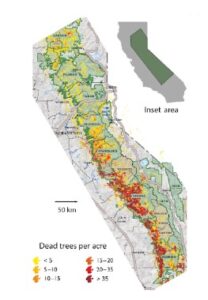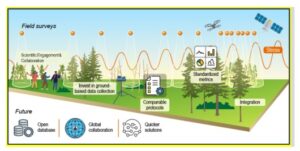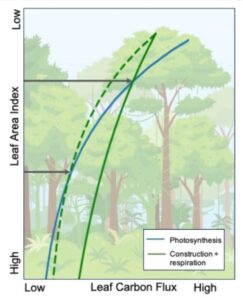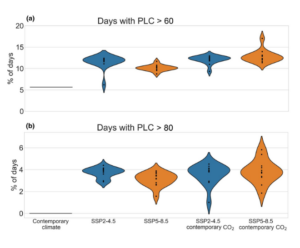Disproportionate resistance to water flow in leaves helps trees maintain their vascular function, but the effect declines as trees grow larger.
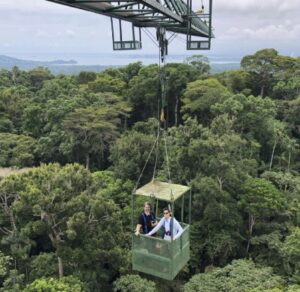
Researchers used cranes to access tree crowns for measurements pressure gradients within trees, which were used to assess the constriction of water flow within leaves.
The Science
Trees move large quantities of water from soil to the atmosphere in the transpiration stream, forming a major component in Earth’s water cycle. Water in the transpiration stream is pulled through trees under tension (i.e., negative pressure) in specialized conduits. When tension is excessive, vascular disfunction occurs. Compared to conduits in roots and stems, leaf conduits constrict water flow. This constriction reduces tension upstream, protecting stem and leaves from vascular disfunction. Variation among trees in this constriction is not well resolved. This study assessed variation in the extent to which tree leaves constrict water flow in the transpiration stream.
The Impact
Results showed that, on average, about half the total resistance to water flow within trees is located within leaves. This indicates that tree leaves are generally highly constrictive to water flow in the transpiration stream. Larger trees tended to have a lower proportion of total resistance to water flow within their leaves. This suggests that leaves in larger trees are less effective at protecting stems and roots from vascular disfunction associated with high water tension. These results help to understand and predict transpiration rates and tree mortality during droughts and heat waves.
Summary
Researchers compiled new and previously published measurements into a multibiome dataset to assess variation among trees in the fraction of whole-tree hydraulic resistance that is in leaves (fRleaf). The measurements relied on pressure differences between leaves, stems, and roots in transpiring trees. Among 80 samples, fRleaf averaged 0.51, was consistent among biomes, and declined with tree height. The results show that leaves play an important role in controlling the flow rate and tension of water in the transpiration stream. Because higher fRleaf protects stems from vascular disfunction and fRleaf declines with tree height, taller trees may be at greater risk of vascular disfunction during droughts. This effect may contribute to the disproportionate drought mortality that has been observed among tall trees.
Contact
Brett Wolfe
Louisiana State University Agricultural Center
wolfe1@lsu.edu
Funding
-Next Generation Ecosystem Experiments‐Tropics funded by the US Department of Energy, Office of Science, Office of Biological and Environmental Research
-United States Department of Energy contract to Brookhaven National Laboratory
-Smithsonian Tropical Research Institute post-doctoral fellowship
-National Institute of Food and Agriculture, US Department of Agriculture, McIntire Stennis Project
-Innovation and Technology Fund (funding support to State Key Laboratories in Hong Kong of Agrobiotechnology) of the HKSAR, China
-US National Science Foundation
-USDA NIFA Hatch Project through the Maine Agricultural and Forest Experiment Station.
Publications
Wolfe, B. T. et al. Leaves as bottlenecks: The contribution of tree leaves to hydraulic resistance within the soil−plant−atmosphere continuum. Plant, Cell & Environment 46, 736–746 (2023). [DOI: 10.1111/pce.14524
